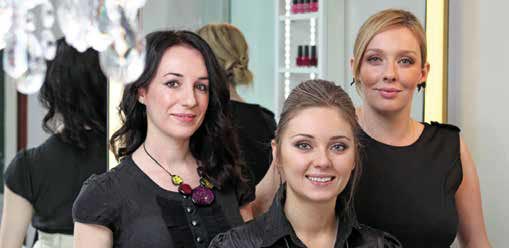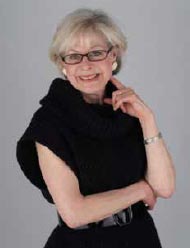Does make-up all look the same to you? Are you tired of telling your Revlon from your Lancôme? If that’s the case, you might want to pay a visit to a small boutique where every foundation or eye-shadow is bespoke, says Caroline Davies
Near the coffee shops and restaurants of Motcomb Street, in a quiet corner of London’s Knightsbridge, sits Cosmetics à la Carte, small and unobtrusive. Cream carpeted with soft furnishings, make-up displayed plainly on the small table in the centre, it has the reassuring feel of a store that has no need to shout; the people who know about it, know it well.
Cosmetics à La Carte began in 1973, founded by Christina Stewart and Lynne Sanders. The two originally met in the lab, working for Unilever Research and moved together to Yardley where they formulated Marks and Spencer’s first make-up range and various Vidal Sasson hair products. Bored of the mass production line, they left to start their own make-up revolution — tailor-made make-up. Need a lipstick to match your dress, an eye-shadow to suit your floral arrangements or a foundation that, well, matches you? Stewart and Sanders had the know-how to whip one up.
In the company’s laboratory in Battersea, two large white rooms are piled high with carefully marker-penned cardboard boxes, neatly sealed bags of multi-coloured powders and Bunsen burners. I find Sanders, dressed in a white lab coat, bent over the hob. It isn’t a hob of course, but to my untrained eye, this is the closest I can come to describing the black heated pad where she is carefully melting a blood red waxy chunk.
Now the sole proprietor since Stewart retired in 2009, Sanders is still in the laboratory although she is in her 60s. Her lab coat flaps around her neat skirt as she swirls across the room and I am surprised to notice only a touch of makeup, a slight line of carefully applied blue eyeliner over her wide eyes. She greets me with a broad smile and a brisk, perfect Received Pronounciation ‘hello’ before energetically enlightening me on the contents of the bottles on her worktop. She is currently melting me a lipstick, a mixture of ‘Santa’ (“we used to call it ‘blood’ but that proved an unpopular name”) and ‘Tulip’, combined together to make the colour of a red hat I brought into the shop a few days before. My eyes wander along the surface to the small glass beakers, filled with varying shades of beige to brown liquid and marked in black pen with household names; foundations in progress for famous faces.
“She requires a thick layer to cover the marks on her skin,” says Sanders, pointing to one such pot. “You would never know though.” She is right, you wouldn’t.
Cosmetics à La Carte did not meet with immediate success. When the revolution proved rather slow to pick up, Stewart and Sanders found themselves without much income and without a team. Undeterred, Sanders found a job in a wine bar to pay for the bills and keep the business afloat.
“Can you imagine?” she says. “Well, it all seemed rather jolly at the time.”
Bizarrely, it does sound it, although perhaps because Sanders’ bright, matter-of-fact manner, not dissimilar to a retired old-school Montessori teacher, means most things sound enjoyable. The grand tour continues into the other laboratory where she pops open tubs of brightly coloured pastes and gels, rubbing them on the back of her hand to show the colour and the consistency before explaining the science. She speaks about polymers with much the same interest and passion as a new parent talks about their child. Jumping from science to backstage anecdotes at fashion week and film sets, Sanders’ enthusiasm for her profession is infectious if occasionally over my head.
Cosmetics à La Carte’s luck started to change and gradually the pair began to gain recognition. Make-up artists hunting for an exact historical shade, ravaged screen sirens looking to replicate the dewy complexion of their youth, trendsetters pushing beyond the palette; the drip feed of visitors to the little shop grew. Sanders still remembers the late afternoon in the 80s when Princess Diana dropped by.
“She wanted a nude lipstick, a very particular colour that would suit her,” she says. “We tried out a few selections, made them up and put it together. We still sell her shade today.”
Picking up on the popularity of bespoke make-up, other companies began to try to mimic Cosmetic à La Carte’s model, but none of the large make-up brands have sustained it. The company’s size has fuelled its success — small, but precise.
While most tailored services rely on remixing pre-existing colours, chopping a little more crimson with peach to roughly suit, Cosmetics à La Carte goes a step further. Arrive in store with the remnants of an old lipstick, blusher, foundation or eye powder and they will remake it, from scratch, to suit. Allergies, sensitive skin, thicker consistency; they can accommodate it. Perhaps this is why they are such a success with pedantic period dramas; I am told the Downton Abbey girls adore it.
As she rummages into another corner, Sanders suddenly stops. A look of horror creeps across her face and with a small gasp, she runs from the room. “Oh no, no, stupid.” Bemused, I follow to find her sighing over the hob.
“Singed. That was not the shade we were going for.”
Apparently, the bloody red wax has now gone past the point of return. She throws it away with an air of sadness. Despite spending over 40 years in the laboratory, Sanders’ attachment to her work and her creations is touching. I watch her carefully dissect the wax again, keeping a suspicious eye on it as it melts into a dark red liquid. She pours it into a mould, cuts it out and fastens it into a gleaming new case, complete with a hand written label.
“I’ll keep this with the others,” Sanders says, slicing away a small section of the remainder of the lipstick still in the mould and sealing it in a bag marked with my name. “For when you come back.”
She opens a drawer under the cabinet and I glimpse a host of names and titles that would rival a royal wedding party guest list, all written in the same handwriting with fresh waxy off-cuts. It seems I’m not the only one expected to return to the little cream shop in Knightsbridge.










